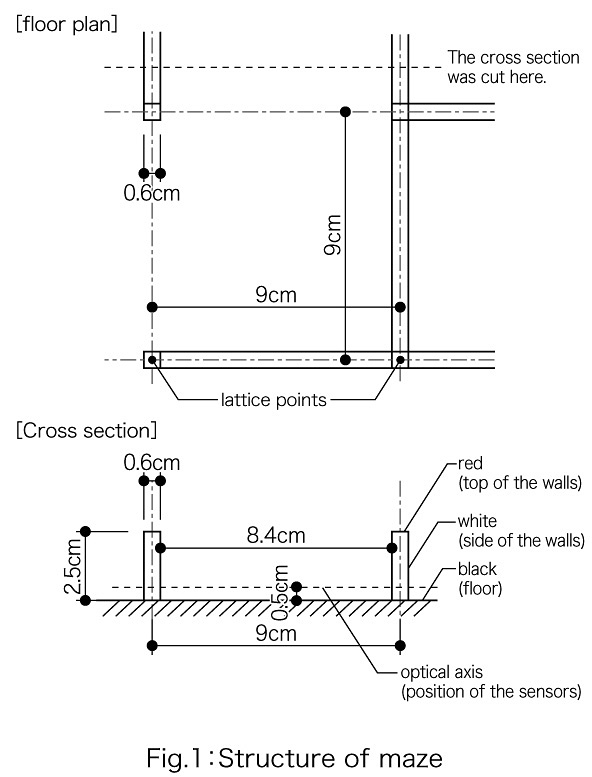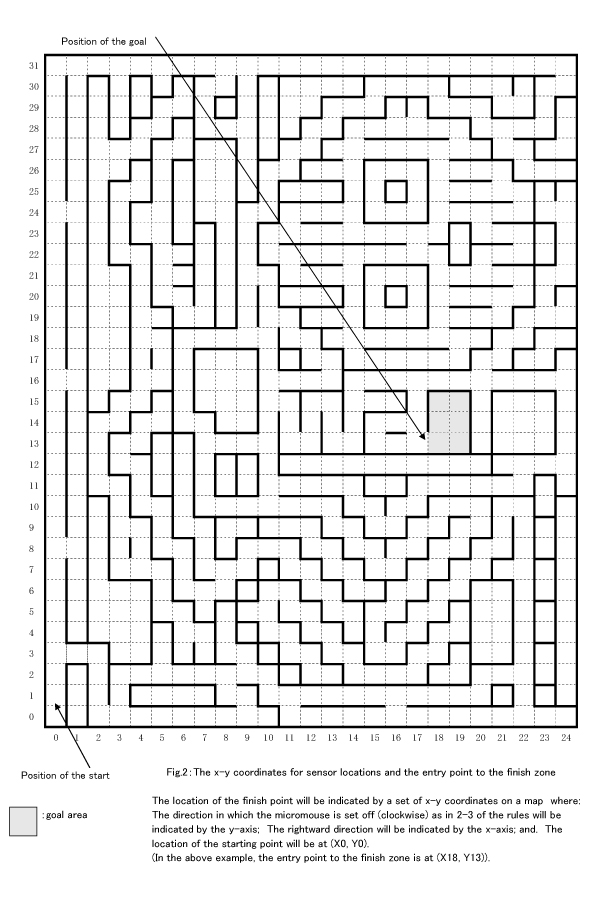- Schedule(Japanese)
Rules for Micromouse Halfsize
Micromouse Contest is a contest which an autonomous robot runs through a designated maze to compete for intelligence and speed. A robot participating in this contest is termed Micromouse.1. Rules for Micromouse Halfsize 1-1. Micromouse must be autonomous. It is not allowed to use an energy source given by combustion process. 1-2. Micromouse must not have any hardware or software added, deleted, replaced or modified by the operator during the contest. It is however permitted to make minor repairs. 1-3. Micromouse is not allowed to leave any of the parts on the maze. 1-4. Micromouse is not allowed to jump over, climb, scratch, damage or destroy the walls. 1-5. The projection of the Micromouse on the floor must be contained within a square of each sides in 12.5 cm. This must be satisfied even when the shape of the Micromouse changes during the contest. There are no restrictions to the height of the Micromouse. 2. Rules for the Maze. 2-1. The side of the walls are white, and the top of the walls are red. The floor of the maze is painted in black. It is made of wood finished with non-gloss black paint. However, the exterior walls of the starting point (outside the maze) and the interior walls of the finish zone are painted in red. The top of the walls in the starting unit and finish zone is painted white. 2-2. The maze are composed of 9 x 9 cm unit squares. The maximum number of squares will be 32 x 32 squares. The height of the walls is 2.5 cm and its thickness is 0.6 cm (see Fig. 1 for details). 2-3. The starting point of the maze will be located at one of the four corners of the maze. Micromouse starts in a clockwise direction. The finish point and the size of the finish zone will be determined individually for each competition. The entry point to the finish zone will be indicated by a set of x-y coordinates. (See Fig. 2 for an explanation on how to read coordinates.) 2-4. There are Small square zones, each 0.6 cm x 0.6 cm, at the four corners of each unit square. This zone is called lattice points, and a maze are built so that there are at least one wall to a lattice point except for the interior of the finish zone (see Fig. 1 for details). The entire maze will be completely surrounded by exterior walls (see Figs. 1 and 2). 3. Rules for the contest. 3-1. The fastest lap from the start to the finish zone[A1] will be recorded as its official time. Micromouse Contest will be evaluated on the fastest lap and its independence. The criteria for evaluation and the rules for awarding prizes are determined at each contest.[A2] 3-2. After the maze is open to public, the operator is not allowed to feed any maze information to Micromouse. During the contest, the operator is not allowed to change any maze information gathered by the search run, using switch or its kind. 3-3. Micromouse begins its run from a starting point and ends when it came back.The run will also finish when Micromouse stops for 2 seconds or it is approved by chairperson. 3-4. When Micromouse returns to the starting point and beings another run automatically, Micromouse must stop for at least two seconds at the starting point. 3-5. The operator is not allowed to touch the Micromouse during the run unless instructed or given permission by a tournament chairperson[A3] to do so. The tournament chairperson accepts an operator's request to discontinue its run if an apparent malfunction is found in his/her Micromouse's run. For the cases in which a request to discontinue is made for any other reasons, permissions will be made on the condition which all memory of the maze is erased. 3-6. The time limit for Micromouse will be determined individually for each competition within 15 minutes. Micromouse is permitted to make up to 5 runs in the specified timeframe. 3-7. The lap have considered to have completed when the entire lower portion of its body , defined as its portion up to 2.5 cm above the floor level has entered the finish zone. However, elapsed time is measured from the moment the sensors placed at the starting point senses the Micromouse and to the moment the sensor located at the entry point to the finish zone senses the same Micromouse. 3-8. The lightings, temperature and humidity of the room in which the maze is located will be those of an ambient environment. Requests to adjust the lightings will not be accepted. 3-9. The tournament chairperson has the rights to ask to the operator about the Micromouse if it is appropriate. The tournament chairperson also has the rights to stop a run, declare disqualification, or ask for instructions if it is appropriate. 3-10. Prizes and evaluation criteria will be set individually for each competition. [Attention]
|

